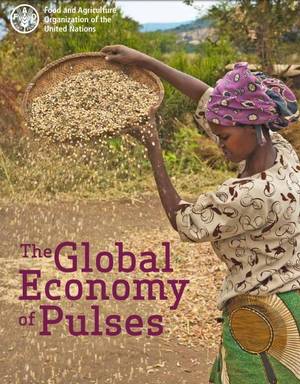 The Global Economy of Pulses, a key research output of the International Year of Pulses 2016, has been released by the FAO.
The Global Economy of Pulses, a key research output of the International Year of Pulses 2016, has been released by the FAO.Bulk of the work for the report, edited by Vikas Rawal and Dorian K Navarro, was done by a research team of the Society for Social and Economic Research (SSER), New Delhi.
- The report The Global of Economy Pulses examines the trends and patterns of this growth, and the factors that explain these for different kinds of pulses.
- The report presents an analysis of trends of consumption of pulses in different regions of the world and discusses the role that pulses can play in human nutrition.
- The report presents an analysis of the dynamics of growth of major pulses in different pulse-producing countries of the world. It describes the increasingly important role of trade in the global economy of pulses and presents an analysis of changing patterns of trade.
- The report argues that there is a pressing need to close the large gap between potential and actual yields, particularly on smallholder farms in South Asia and sub-Saharan Africa, by increased adoption of improved varieties and modern agronomic practices in all developing countries. This in turn requires a major thrust in agricultural research and extension, improving credit availability, and public investment directed at pulse production.
- The report discusses future prospects and policy imperatives for sustaining the growth of pulse production.
The report comprises 10 chapters.
- Introduction (Boubaker Ben Belhassen, Vikas Rawal and Dorian Kalamvrezos Navarro)
- Pulses: Nutritional Benefits and Consumption Patterns (Vikas Rawal, Ruth Charrondiere, Maria Xipsiti and Fernanda Grande)
- Chickpea: Transformation in Production Conditions (Vikas Rawal and Prachi Bansal with contributions from Kanika Tyagi)
- Pulses of Phaseolus and Vigna Genera (Prachi Bansal, Vikas Rawal and Vaishali Bansal)
- Lentil: Emergence of Large-scale, Export-oriented Production (Vikas Rawal and Vaishali Bansal)
- Pigeonpea: Smallholder Production (Jesim Pais and Vaishali Bansal)
- Dry Pea: Production Driven by Demand for Animal Feed (Prachi Bansal and Vaishali Bansal)
- Pulses of the Vicia genus (Prachi Bansal)
- Value Chains and Markets (Mandira Sarma, Jesim Pais and Vaishali Bansal with contributions from Robert Burden)
- Drivers of Growth and Future Growth Prospects (Vikas Rawal with contributions from Merritt Cluff)
Related:
Video interviews:
Interview (Oct. 2017) with Vikas Rawal, Professor of economics Jawaharlal Nehru University, New Delhi- Co-Editor of The Global Economy of Pulses (FAO, September 2019, 190 pages)
- Rate of Growth of Minimum Support Prices of Crops Slowed Down
“Farmers have to be encouraged to cultivate pulses for the sake of food security and as an import substitution measure. The global demand for pulses depends on the Indian consumption of pulses. It is really dependent on growth demand from India.”
Interview (Dec. 2016) with Dorian Kalamvrezos Navarro, Consultant, Division du commerce et des marchés (EST) FAO
- Co-Editor of The Global Economy of Pulses
- Pourquoi faut-il manger des légumineuses ? - L'Esprit Sorcier
« La production est géographiquement très concentrée. L’Inde représente à elle seule un quart de la production mondiale. Il-y-a plusieurs contraintes dans la production des légumineuses. Cela va des insectes, maladies, au climat, des précipitations incertaines, passant aussi par des contraintes institutionnelles, infrastructurelles. Il est de plus en plus évident que la clé pour l’augmentation de la production des légumineuses a l’échelle mondiale est politique et pas seulement technique. Dans beaucoup de pays il y a une politique agricole qui accorde une préférence à la production et auto-suffisance céréale. La production des légumineuses a été déplacée systématiquement vers des zones marginales, laissant les zones fertiles à d’autres cultures. On a surtout besoin de politiques et programmes appropriés, pour renforcer le système de production des légumineuses sur le terrain pour encourager la commercialisation des légumineuses dans des systèmes commerciaux locaux et aussi pour renforcer des habitudes de consommation durable. »

No comments:
Post a Comment